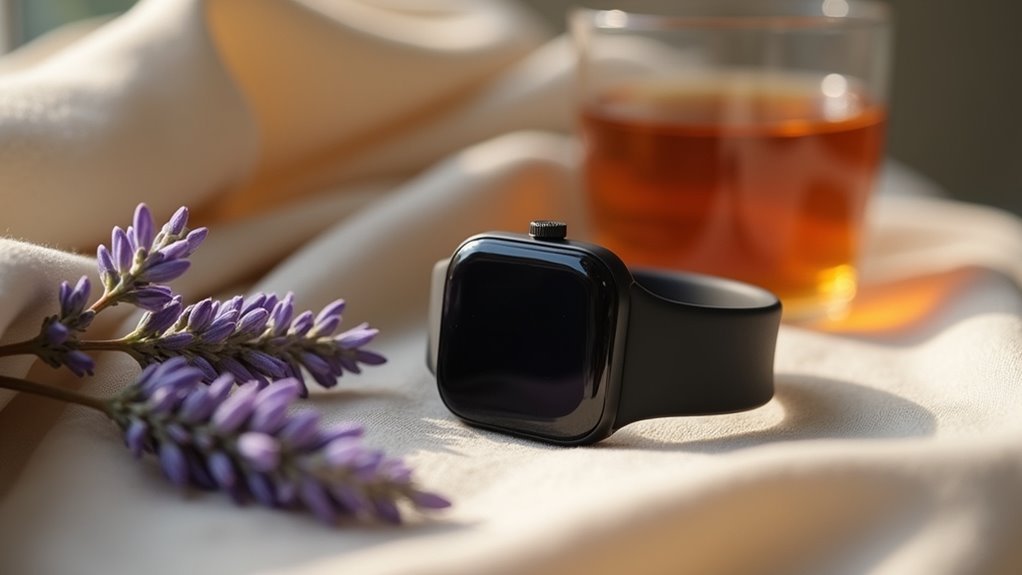You can track essential health metrics through smartwatches that monitor your menstrual cycle, heart rate variability, sleep quality, and body composition. These devices help you optimize training by identifying your heart rate zones, tracking recovery patterns, and adjusting nutrition goals based on your cycle phases. With 50% of female athletes already using wearables for menstrual tracking, you’ll gain real-time insights into sleep disturbances, calorie burn, and movement patterns that directly impact your performance and injury prevention strategies.
Essential Health Metrics Every Female Athlete Should Monitor
When you’re pushing your body to its limits as a female athlete, tracking the right health metrics becomes vital for enhancing performance and preventing injury. Your menstrual cycle should be your top priority – 50% of female athletes already use wearables to track hormonal fluctuations and schedule training around cycle phases.
Tracking menstrual cycles has become essential for female athletes, with half already using wearables to optimize training around hormonal fluctuations.
Don’t overlook sleep quality, as it’s important for recovery and cognitive function. Monitor your heart rate variability to assess stress and recovery levels, helping you adjust training intensity accordingly.
Body composition tracking, particularly fat percentage, directly impacts your performance across different sports. Your respiratory rate and maximum oxygen intake reveal your aerobic capacity and endurance levels.
Finally, watch your body temperature to identify potential infections early and guarantee ideal recovery between training sessions. Additionally, monitoring your glucose levels can prevent the performance drops that commonly affect long-distance runners when blood sugar becomes inadequate.
Heart Rate Zones and Performance Optimization for Women
Understanding your heart rate zones transforms how you approach training as a female athlete, giving you the precision needed to maximize every workout.
Zone 1 (50-60% HR max) handles recovery and warm-ups, while Zone 2 (60-70%) builds endurance and burns fat effectively. You’ll develop speed and strength in Zone 3 (70-80%), push your lactate threshold in Zone 4 (80-90%), and achieve maximum intensity in Zone 5 (90-100%).
Your smartwatch becomes essential for monitoring these zones in real-time. Plan 3-5 Zone 2 sessions weekly for aerobic capacity, incorporate Zone 3 strength work, and use Zone 4 intervals strategically.
Calculate your max heart rate using 220 minus your age, then adjust zones based on your fitness level. Training across all five zones creates diverse physiological adaptations that enhance overall performance. Consistent training across all zones prevents plateaus while proper recovery prevents overtraining injuries.
Menstrual Cycle Impact on Athletic Performance and Recovery
Your menstrual cycle greatly affects both your athletic performance and recovery through hormonal fluctuations that smartwatches can now help you track and optimize.
You’ll find that monitoring cycle phases alongside performance metrics reveals patterns in your strength, endurance, and recovery that weren’t visible before. Elite female soccer players commonly experience increased fatigue and decreased physical power during menstruation, making cycle tracking essential for performance optimization.
Cycle Phase Performance Tracking
Although your smartwatch can’t measure hormones directly, it captures performance metrics that reveal how your menstrual cycle affects your athletic abilities.
You’ll notice variations in heart rate, power output, and recovery data across different phases. During your follicular phase, when estrogen dominates, your watch might show improved cardiovascular metrics and enhanced endurance performance due to better glucose uptake and vasodilation.
However, in the luteal phase, progesterone’s effects appear as elevated resting heart rate and reduced metabolic efficiency on your device. Elite female athletes often demonstrate heightened sensitivity to these hormonal fluctuations, requiring more individualized training approaches based on cycle-specific data patterns.
Your smartwatch data helps identify patterns between perceived performance drops and actual metrics. While you might feel worse during menstruation or late luteal phases, objective measurements sometimes contradict these perceptions, allowing you to distinguish between hormonal symptoms and genuine performance changes.
Hormonal Recovery Optimization
When progesterone surges during your luteal phase, your smartwatch reveals the hidden cost: elevated resting heart rate, slower heart rate variability recovery, and extended sleep onset times that signal your body’s working harder to repair itself.
| Phase | Recovery Strategy |
|---|---|
| Follicular | Leverage enhanced lipolysis for fat-burning workouts |
| Ovulation | Maximize high-intensity training with peak estradiol |
| Luteal | Prioritize protein intake, extend recovery periods |
| Menstrual | Focus on gentle movement, iron-rich nutrition |
Your watch data becomes invaluable for timing nutrient intake. During luteal phases, you’ll need 15-20% more protein to combat increased catabolism. Track sleep metrics closely—if deep sleep decreases below baseline, reduce training intensity by 10-15%. Women using combination contraceptives show the most pronounced reduction in recovery compared to naturally cycling athletes, making consistent monitoring even more critical. This data-driven approach prevents overreaching while optimizing your body’s natural hormonal fluctuations for peak performance.
Training Schedule Adaptation
Smartwatch metrics can transform how you structure your training schedule by revealing performance patterns that align with your menstrual cycle phases.
You’ll notice variations in heart rate, recovery metrics, and perceived exertion throughout different phases, allowing you to adjust training intensity accordingly.
During your follicular phase, when estrogen peaks, you can capitalize on improved cardiovascular function by scheduling high-intensity workouts.
Conversely, during the luteal phase, elevated progesterone may increase your body temperature and metabolic strain, suggesting lighter training loads.
Rather than following rigid programs, you can personalize your approach based on your body’s signals. Research emphasizes the importance of personalized training approaches due to significant individual variation in how athletes respond to different menstrual cycle phases.
Track metrics like heart rate variability and sleep quality to determine ideal training windows.
This data-driven adaptation helps you maximize performance while respecting your body’s natural fluctuations.
Sleep Quality Tracking for Enhanced Athletic Recovery

While you’re pushing your body to its limits during training and competition, your recovery happens primarily during sleep—making sleep quality one of the most critical factors in your athletic performance. Deep sleep phases are when your body undergoes tissue repair, muscle growth, and immune system strengthening essential for athletic recovery.
Your wearable device tracks key metrics like sleep efficiency, disturbances, and total sleep time using movement patterns and heart rate variability. Research shows that poor sleep quality directly correlates with decreased shooting accuracy and lower scoring in women’s basketball athletes, proving that quality matters more than quantity.
- Movement-based monitoring: Your device uses actigraphy principles to detect restlessness and stillness patterns throughout the night
- Performance correlation: Sleep disturbances negatively impact field goals, points scored, and overall game performance metrics
- Personalized insights: Continuous tracking helps identify your individual sleep patterns for tailored recovery strategies
Nutrition and Calorie Management Through Wearable Technology
You’ll find that modern smartwatches can track your calorie burn with impressive accuracy by combining heart rate data, movement patterns, and personal metrics.
Setting clear nutritional goals through your device helps you maintain the energy balance needed for peak performance and recovery.
Your watch becomes a powerful tool for monitoring whether you’re fueling your body appropriately for training demands and competition schedules. These devices provide real-time data on your nutritional intake patterns, enabling you to make immediate adjustments to optimize your athletic performance.
Calorie Tracking Accuracy
Despite their widespread popularity among female athletes, fitness watches struggle with a fundamental limitation: their calorie tracking accuracy ranges from disappointing to downright unreliable.
You’ll find error rates spanning from 27% to 93%, depending on your device model and workout intensity. These inaccuracies worsen during vigorous exercise sessions and specific activities like cycling or resistance training.
As a female athlete, you can’t rely solely on these estimates for nutrition planning. The algorithms weren’t designed with women’s unique metabolic responses in mind, creating additional complications for accurate tracking. This oversimplified approach ignores how your body processes different calorie types from various macronutrients, further compromising the usefulness of these measurements.
- Heart rate measurements remain accurate within 5% while calorie estimates fail dramatically
- Higher workout intensities produce worse calorie underestimations affecting your energy balance calculations
- Cycling and resistance exercises show the poorest tracking reliability compared to walking or running
Nutritional Goal Setting
Given these calorie tracking limitations, setting accurate nutritional goals requires a more sophisticated approach than relying on your watch’s basic estimates.
Modern wearables now use your collected biometric data to establish individualized calorie and macronutrient targets based on your activity levels and physiological states. Your device can adapt these goals accounting for training intensity, recovery status, and menstrual cycle phases that uniquely affect female athletes’ metabolic needs.
Advanced systems extend beyond simple calorie counting to micronutrient adequacy when biomarker feedback is available. Female athletes face significantly higher injury risks that require specialized nutritional support for optimal recovery and performance.
You’ll find nutrition goals automatically adjust as your device learns from continuous data collection, promoting behavioral changes toward healthier eating habits. This personalized approach helps you maintain proper energy balance while supporting your specific performance and recovery requirements throughout different training phases.
GPS and Movement Analysis for Training Precision
When you’re tracking your training performance, GPS technology transforms how you measure and analyze movement with remarkable precision. Your GPS-enabled watch provides real-time insights into speed, acceleration, and effort levels, enabling you to make informed training decisions instantly.
GPS technology revolutionizes training analysis, delivering real-time movement insights that enable instant, data-driven performance decisions.
You’ll receive accurate measurements even during agility courses, with devices like the VX Sport delivering reliable data at various frequencies. Your coaches can tailor training programs specifically to your needs using this precise movement data.
You’ll benefit from workload management that prevents overtraining and reduces injury risk. The technology helps analyze your movement patterns, supporting strategy development and performance enhancement across various team sports. This data-driven approach moves beyond traditional coaching intuition to provide objective insights for optimal performance decisions.
- Real-time performance metrics track speed, distance, and acceleration during training
- Customized training programs based on your individual movement data and performance needs
- Injury prevention monitoring through precise workload management and performance analysis
Injury Prevention Through Real-Time Health Monitoring
While GPS technology optimizes your training sessions, your smartwatch offers an even deeper layer of protection through continuous health monitoring that actively prevents injuries before they occur.
Your device collects real-time physiological data including heart rate, sleep patterns, and stress levels to identify anomalies that signal overexertion or potential injuries.
When your watch detects concerning patterns, you can immediately adjust training intensity and schedules. This real-time feedback helps you reach peak performance while minimizing long-term health risks.
Edge computing processes your data instantly, enhancing decision-making for both you and your coach. Research analyzing 11,277 data points from Division 1 female soccer athletes demonstrates the effectiveness of continuous monitoring in identifying significant correlations between physiological responses and injury risk.
For female athletes, this monitoring becomes even more essential since you’re at higher risk for certain injuries like ACL tears, and your menstrual cycle affects recovery patterns and injury susceptibility.
Hormonal Fluctuations and Energy Management in Sports
Beyond tracking basic metrics, your smartwatch becomes a powerful ally in understanding how hormonal fluctuations directly impact your athletic performance and energy levels throughout your menstrual cycle.
Research reveals that 50% to 80% of elite athletes report being affected by PMS, yet cognitive performance actually peaks during menstruation despite feeling otherwise. Your watch monitors heart rate variability and sleep patterns, providing insights into how hormonal changes affect your body’s responses.
Energy management requires understanding both physical and psychological impacts of these fluctuations. By tracking physiological markers through your device, you can anticipate different cycle phases and adjust training accordingly. The relationship between menstruation and performance is multi-factorial and bidirectional, making individual tracking essential for understanding your unique patterns.
- Monitor sleep quality and stress levels to identify hormonal impact patterns
- Use heart rate data to optimize training intensity during different menstrual phases
- Track energy fluctuations to develop personalized nutrition and recovery strategies
Frequently Asked Questions
Which Smartwatch Brands Offer the Most Accurate Tracking for Female Athletes?
You’ll find Apple Watch Series, Garmin Forerunner/Fenix, and Fitbit Charge 6 offer the most accurate tracking. They’re specifically tested for women’s fit and provide precise heart rate, GPS, VO2 Max, and sleep measurements.
How Long Does a Fitness Watch Battery Typically Last With Continuous Monitoring?
You’ll typically get 6-15 days of battery life with continuous heart rate and health monitoring. GPS usage drops this to 5-38 hours depending on your watch model and features.
Are Fitness Watches Waterproof Enough for Swimming and Water Sports Training?
Most fitness watches with 5 ATM ratings handle swimming well, while 10 ATM models support water sports. You’ll get swim tracking features, but avoid hot showers and rinse after saltwater exposure.
Can Multiple Health Apps Sync Data From the Same Fitness Watch Simultaneously?
Yes, you can connect multiple health apps to sync data from your fitness watch simultaneously. Health Sync enables this multi-app connectivity, letting you automatically share your watch data across different platforms seamlessly.
What’s the Average Cost Difference Between Basic and Advanced Athletic Tracking Watches?
You’ll find basic athletic tracking watches average around $105, while advanced models cost $350-$450 or more. That’s a cost difference of roughly $250-$345 between entry-level and feature-rich options.




Leave a Reply